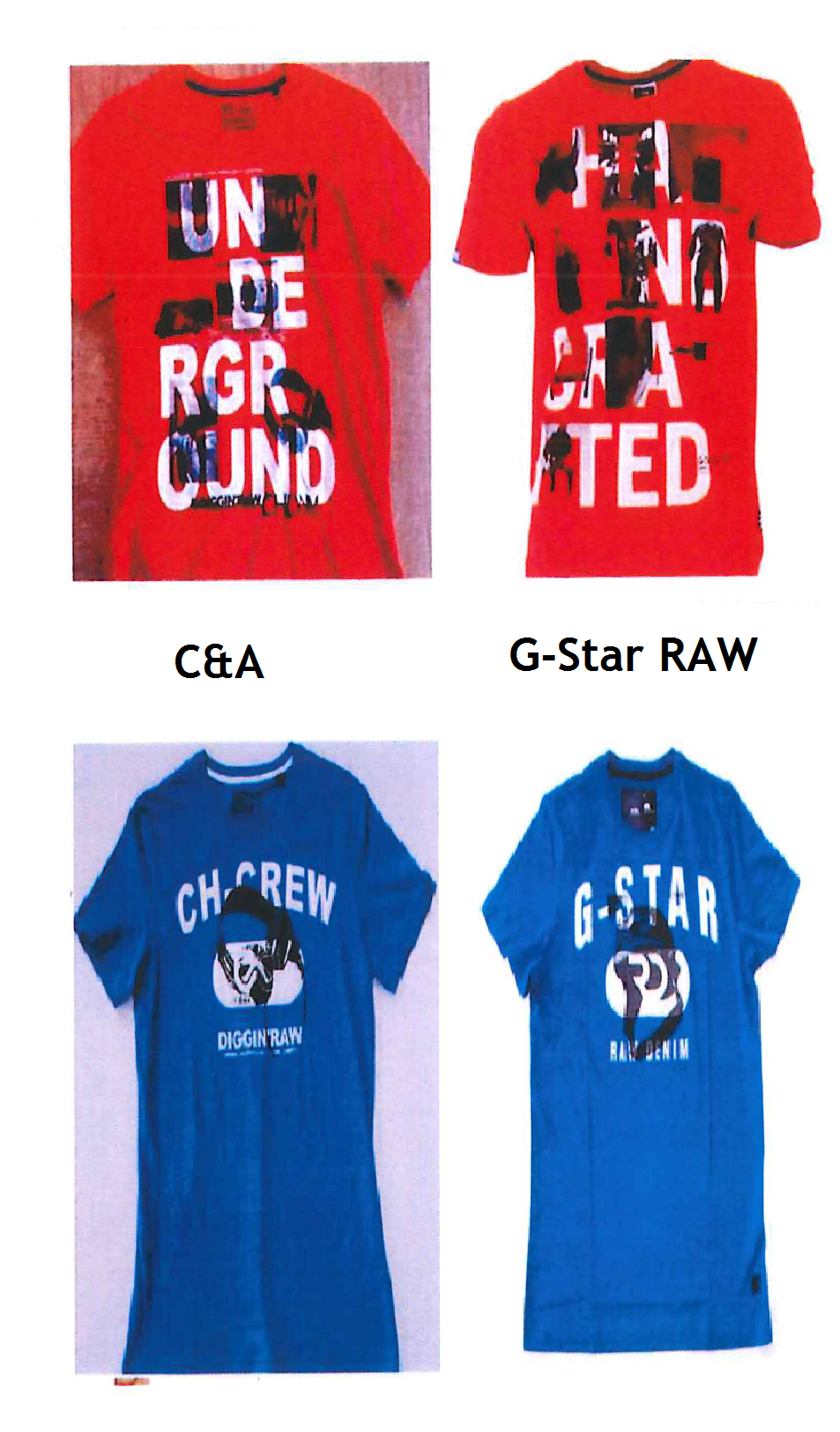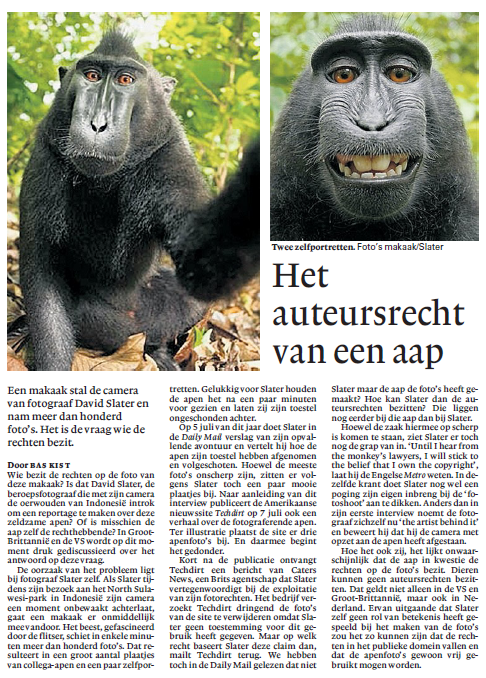Ik vind RAW leuk
 Met dank aan Laura Fresco en Joris van Manen, Hoyng Monegier LLP en Christien Wildeman en Alfred Meijboom, Kennedy Van der Laan.
Met dank aan Laura Fresco en Joris van Manen, Hoyng Monegier LLP en Christien Wildeman en Alfred Meijboom, Kennedy Van der Laan.
Merkenrecht. Kleding RAW, DIGGIN'RAW en DigginRAW. Marktonderzoek.
In eerder vonnis van Haagse voorzieningenrechter werd geoordeeld dat C&A en Wehkamp kleding voorzien van het teken “D STR” niet meer te koop mochten aanbieden, omdat daarmee (artikel 9 lid 1 GMV jo. artikel 2.20 lid lid 1 BVIE) “sub c”-inbreuk wordt gemaakt op de bekende G-STAR merken van G-Star (IEF 9888).
In dit vonnis wordt door de voorzieningenrechter inbreuk op basis van “sub a” en “sub b” toegewezen. Het gebruik van het teken RAW, al dan niet in combinatie met andere elementen zoals RAW-DNM en D/925/RAW is volgens de rechter gelijk aan het RAW merk van G-Star en wordt gebruikt voor dezelfde waren, namelijk kleding. Dat levert “sub a” inbreuk op. Ten aanzien van de tekens DIGGIN’RAW en DigginRaw is er volgens de voorzieningenrechter sprake van verwarringsgevaar met de RAW merken van G-Star en dus inbreuk in de zin van “sub b”. De rechter merkt daarbij nog op dat het merk RAW van G-Star onderscheidend vermogen van huis uit heeft voor kleding (r.o. 4.5).
Stakingsvorderingen worden toegewezen en wordt bevolen dat C&A Nederland schriftelijk opgave moet doen, gecertificeerd door een registeraccountant, van hetgeen haar bekend is omtrent de herkomst en distributiekanalen van de inbreukmakende kleding. Ook moet aan afnemers in de gehele Europese Unie een brief gestuurd worden om de aanwezige voorraad inbreukmakende kleding te retourneren aan C&A Nederland.
Dwangsommen van EUR 10.000 per dag of EUR 1.000 per kledingstuk betalen tot een maximum van EUR 1.000.000. En proceskostenveroordeling gedaagden €79.341,78.
4.5. Daarenboven is het ingeroepen merk voor de waren kleding (in het algemeen, dus niet enkel onbewerkte jeans) naar voorlopig oordeel niet beschrijvend en heeft het van huis uit onderscheidend vermogen. G-Star heeft overlegt een verslag van een onder leiding van een kantoorgenoot van haar raadsman uitgevoerd onderzoek onder 458 respondenten naar de bekendheid van het Gemeenschapsmerk. Volgens dit verslag zou bij de confrontatie met het teken RAW en gevraagd waaraan zij dachten circa 30% van de respondenten de naam G-Star of GapStar (de rechtsvoorganger van G-Star Raw) zijn genoemd. (...) Voorhands kan in ieder geval mede op grond van de marktonderzoeken naar de bekendheid van het RAW merk worden aangenomen dat het publiek in staat is aan de hand van de aanduiding RAW de kleding van G-Star te onderscheiden van die van andere ondernemingen en dat het merk RAW dus onderscheidend vermogen heeft.
4.12. Op grond van het hiervoor overwogene oordeelt de voorzieningenrechter voorhands dat ten aanzien van de Dissident kleding voorzien van het teken RAW sprake is van merkinbreuk 'sub a', zodat voor die kleding op die grond een inbreukverbod toewijsbaar is.
4.13. Met betrekking tot de DigginRaw kleding acht de voorzieningenrechter voorhands aannemelijk dat de gemiddelde consument niet enkel het teken RAW zal opvatten als aanduiding van de herkomst van de waren, maar dat hij daarin steeds mede het teken "DIGGIN" zal betrekken. De kleding toont immers geen gebruik van RAW zonder DIGGIN. De verschillen tussen deze (combinatie van) tekens en de ingeroepen merken zijn meer dan onbeduidend. Er is daarom geen sprake van een gelijk teken zoals bedoeld in artikel 9 lid 1 sub a GMVo c.q. artikel 2.20 lid 1 sub a BVIE, zodat het gevorderde ten aanzien van de DigginRaw kleding niet op die grondslag voor toewijzing in aanmerking komt.
4.15. Daarenboven, zelfs al zouden de DigginRaw tekens als versiering moeten worden beschouwd, dan neemt dat nog niet weg dat deze tekens zodanig kunnne overeenstemmen met het RAW merk dat het relevante publiek de waren opvat als afkomstig van G-Star of van een met G-Star economisch verbonden onderneming, niettegenstaande het mogelijk ook decoratieve karakter van het gebruik van de tekens (vergelijk HvJEG 10 april 2008, LJN BL3906 inzake Adidas AG/Marca Mode c.s. overweging 34). Zoals hierna zal worden overwogen doet dat zich in het onderhavige geval voor.
Inbreuk 'sub b'
4.16. Maatstaf voor het bij 'sub b' vereiste verwarringsgevaar is of het merk zoals ingeschreven en de door C&A gebruikte tekens op haar kleding als weergegeven onder 2.8 globaal beoordeeld een zodanige gelijkenis vertonen dat daardoor verwarring kan ontstaan bij het publiek ten aanzien van de herkomst van de kleding, dan wel dat er indirect verwarringsgevaar kan ontstaan, doordat de indruk wordt gewekt dat er een commerciële band bestaat tussen G-Star en C&A. De globale beoordeling van het verwarringsgevaar dient, wat de visuele, auditieve of begripsmatige gelijkenissen tussen de merken betreft, te berusten op de totaalindruk die door teken en merken worden opgeroepen, waarbij in het bijzonder tekening dient te worden gehouden met hun onderscheidende en dominerende bestanddelen. Daarbij geldt dat naarmate de soortgelijkheid van de waren waarvoor het merk is ingeschreven en de waren die onder het teken worden aangeboden groter is, er eerder sprake is van overeenstemming tussen merk en teken. Voorts neemt het gevaar voor verwarring toe naarmate de onderscheidende kracht van het merk groter is.4.25. De voorzieningenrechter oordeelt op grond van dat alles voorhands dat C&A door het gebruik van de tekens DigginRaw, DIGGIN'RAW en Diggin Raw voor waren waarvoor het merk is ingeschreven inbreuk maakt op het merk RAW van G-Star als bedoeld in artikel 9 lid 1 sub b GMVo en artikel 2.20 lid 1 onder b BVIE.
Lees het vonnis hier (pdf / schone pdf)
 Commentaar in't kort, met dank aan Eliëtte Vaal,
Commentaar in't kort, met dank aan Eliëtte Vaal,  Merkenrecht. Oppositie o.g.v. ouder woord-/beeldmerk EMI tegen woord-/beelmerk KMI Music Bank. Oppositiebeslissing. Deels toegewezen. Merk wordt niet ingeschreven voor de waren waartegen oppositie is ingesteld (Kl. 9: Dvd's, Cd's, Blue-ray en overige beeld- en geluidsdragers alsook publicaties in elektronische vorm en Kl. 16: publicaties in gedrukte vorm). Wel ingeschreven voor Kl. 30: alle waren zoals koffie; meel en graanpreparaten; consumptie-ijs; honing; gist; zout; azijn, kruidensausen; specerijen. Visueel en auditief: in zekere mate overeenstemmend. Conceptueel: niet van toepassing. Vergelijking waren en diensten: identiek voor alle waren van Kl. 9 en Kl. 16. Ingeroepen recht is een bekend merk en heeft daardoor sterk onderscheidend vermogen. Heeft als gevolg daarvan een ruimere beschermingsomvang. Sprake van verwarringsgevaar met betrekking tot waren waartegen oppositie is ingesteld.
Merkenrecht. Oppositie o.g.v. ouder woord-/beeldmerk EMI tegen woord-/beelmerk KMI Music Bank. Oppositiebeslissing. Deels toegewezen. Merk wordt niet ingeschreven voor de waren waartegen oppositie is ingesteld (Kl. 9: Dvd's, Cd's, Blue-ray en overige beeld- en geluidsdragers alsook publicaties in elektronische vorm en Kl. 16: publicaties in gedrukte vorm). Wel ingeschreven voor Kl. 30: alle waren zoals koffie; meel en graanpreparaten; consumptie-ijs; honing; gist; zout; azijn, kruidensausen; specerijen. Visueel en auditief: in zekere mate overeenstemmend. Conceptueel: niet van toepassing. Vergelijking waren en diensten: identiek voor alle waren van Kl. 9 en Kl. 16. Ingeroepen recht is een bekend merk en heeft daardoor sterk onderscheidend vermogen. Heeft als gevolg daarvan een ruimere beschermingsomvang. Sprake van verwarringsgevaar met betrekking tot waren waartegen oppositie is ingesteld. Korte (en oudere) uitspraak. Merkenrecht. Auteursrecht. Portretrecht.
Korte (en oudere) uitspraak. Merkenrecht. Auteursrecht. Portretrecht. Als randvermelding. Deurwaarderskortgeding. Conservatoir bewijsbeslag met betrekking tot IE-recht. Nadat de deurwaarder is aangevangen met de beslaglegging, ontstaat een discussie tussen de advocaten van betrokken partijen over de wijze waarop de beschikking, waarbij verlof is verleend tot het leggen van conservatoir bewijsbeslag met aanstelling van een gerechtelijk bewaarder, moet worden geïnterpreteerd. De deurwaarder heeft op de voet van artikel 438 lid 4 Rv het kort geding tussen partijen aanhangig gemaakt. Uitleg van een beslagverlofbeschikking die is gegeven door ondertekening van de woorden “Toegestaan als verzocht”.
Als randvermelding. Deurwaarderskortgeding. Conservatoir bewijsbeslag met betrekking tot IE-recht. Nadat de deurwaarder is aangevangen met de beslaglegging, ontstaat een discussie tussen de advocaten van betrokken partijen over de wijze waarop de beschikking, waarbij verlof is verleend tot het leggen van conservatoir bewijsbeslag met aanstelling van een gerechtelijk bewaarder, moet worden geïnterpreteerd. De deurwaarder heeft op de voet van artikel 438 lid 4 Rv het kort geding tussen partijen aanhangig gemaakt. Uitleg van een beslagverlofbeschikking die is gegeven door ondertekening van de woorden “Toegestaan als verzocht”. Met dank aan Erik Vollebregt,
Met dank aan Erik Vollebregt,  Met gelijktijdige dank aan Christien Wildeman en Joran Spauwen,
Met gelijktijdige dank aan Christien Wildeman en Joran Spauwen,  Vakantietijd en genieten van lokale streekproducten. Bij meer producten heeft u nu een extra weetje, want recentelijk heeft de Commissie enkele Beschermde Geografische Indicaties toegevoegd voor:
Vakantietijd en genieten van lokale streekproducten. Bij meer producten heeft u nu een extra weetje, want recentelijk heeft de Commissie enkele Beschermde Geografische Indicaties toegevoegd voor:
 met dank aan Bas Kist,
met dank aan Bas Kist, 






















































































